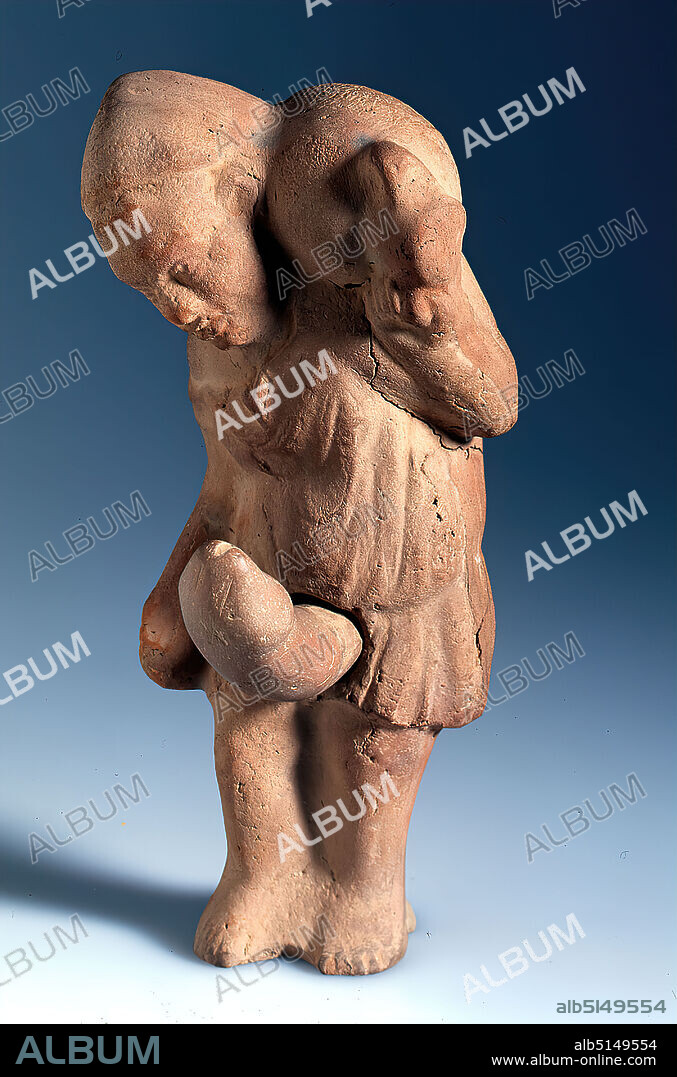alb5149554
Ithyphallic slave with amphora, clay, pressed into the mold, hand-modeled, fired (ceramic), clay, Total: Height: 17.1 cm; Width: 7.6 cm; Depth: 6.6 cm (without phallus); Depth: 9.3 cm (with phallus), Pottery, Man, Masculinity, Early Imperial Period, Middle Imperial Period, The figure shows a slave, who, bent by the weight of a heavy amphora on his left shoulder, shuffles towards his goal. He is clothed with a short thin robe (Greek exomis), which already slips off his shoulder, half-covering his thigh and girded below his waist. On his head he wears a tight-fitting cap. The large ears and the thick nose as well as the long arms and short legs were considered ugly disproportionate and were specific to the depiction of slaves. This caricature of a human being is still carried to extremes by the equipment with an oversized phallus. This is considered both repulsive and lucky. The figure belongs to the group of so-called Fayum terracottas. In Alexandria, the international, Greek-influenced center of Egypt, lives a multicultural society of Egyptians, Orientals, Greeks, Romans, Jews and others, whose different religious ideas are gradually blending together. Insights into this world of faith are provided by the so-called Fayum terracottas. They are part of the religious household, children's toys, knick-knacks, but also cult symbols, grave goods, pilgrimage images, votive offerings and magical objects for banishing evil forces. They can be found in houses, graves and sanctuaries.

|
Zu einem anderen Lightbox hinzufügen |
|
Zu einem anderen Lightbox hinzufügen |



Haben Sie bereits ein Konto? Anmelden
Sie haben kein Konto? Registrieren
Dieses Bild kaufen
Untertitel:
Siehe automatische Übersetzung
Ithyphallic slave with amphora, clay, pressed into the mold, hand-modeled, fired (ceramic), clay, Total: Height: 17.1 cm; Width: 7.6 cm; Depth: 6.6 cm (without phallus); Depth: 9.3 cm (with phallus), Pottery, Man, Masculinity, Early Imperial Period, Middle Imperial Period, The figure shows a slave, who, bent by the weight of a heavy amphora on his left shoulder, shuffles towards his goal. He is clothed with a short thin robe (Greek exomis), which already slips off his shoulder, half-covering his thigh and girded below his waist. On his head he wears a tight-fitting cap. The large ears and the thick nose as well as the long arms and short legs were considered ugly disproportionate and were specific to the depiction of slaves. This caricature of a human being is still carried to extremes by the equipment with an oversized phallus. This is considered both repulsive and lucky. The figure belongs to the group of so-called Fayum terracottas. In Alexandria, the international, Greek-influenced center of Egypt, lives a multicultural society of Egyptians, Orientals, Greeks, Romans, Jews and others, whose different religious ideas are gradually blending together. Insights into this world of faith are provided by the so-called Fayum terracottas. They are part of the religious household, children's toys, knick-knacks, but also cult symbols, grave goods, pilgrimage images, votive offerings and magical objects for banishing evil forces. They can be found in houses, graves and sanctuaries.
Persönlichkeiten:
Bildnachweis:
Album / quintlox
Freigaben (Releases):
Model: Nein - Eigentum: Nein
Rechtefragen?
Rechtefragen?
Bildgröße:
2858 x 4320 px | 35.3 MB
Druckgröße:
24.2 x 36.6 cm | 9.5 x 14.4 in (300 dpi)
Schlüsselwörter:
AEGYPTEN • AMPHORE • AUSRÜSTUNG • DEKORATION • GLAUBE • GLÜCKLICH • GRUPPE • HAUS • HÄUSER • INTERNATIONAL • JUDE • JUDEN • JUEDISCH • KARIKATUR • KERAMIK • KOPF (ANATOMIE) • KOPF • MAENNLICHKEIT • MANN • MENSCH (MENSCHEN) • MENSCH • MENSCHLICH • MÄNNLICHKEIT • NIPPES • OBERSCHENKEL • ORNAMENT • ORNAMENTE • SCHULTER • STEINGUT • TOEPFEREI • TOEPFERWARE • TON • TUMBAS • TÖPFEREI • VERZIEHRUNG • VERZIERUNG • WELT • ZEICHENTRICKFILM • ZIERDE • ÄGYPTEN
 Pinterest
Pinterest Twitter
Twitter Facebook
Facebook Link kopieren
Link kopieren Email
Email
